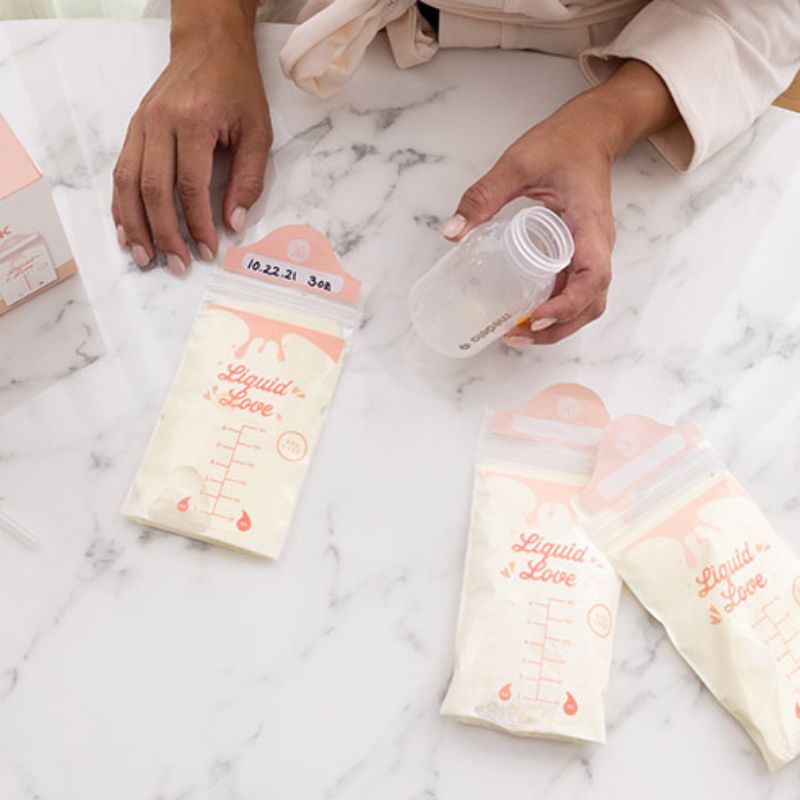You may already know that breast milk is the perfect food for babies, providing them with all of the vital nutrition they need. But did you know that breast milk can come in many different colors? Rest assured, most changes in breast milk color are normal, even if they might seem slightly odd at first.
So what makes breast milk color change?
We’ve pulled together some explanations of the different milk colors you might encounter on your breastfeeding journey (so that you're not up all night googling "What color should breast milk be?" or "Why does breast milk color change?" like we did when we started breastfeeding!).
And remember, no matter what color of breast milk you produce, you are exactly what your baby needs, and while these days, weeks, and months of breastfeeding or pumping may sometimes be challenging, you’re perfectly designed for the job!
Read on for everything breastfeeding parents need to know about the color of breast milk (and for some extra support, check out our patented hands-free pumping and nursing bra!).

Yellow
Colostrum, the very first milk your body produces, will be yellow in color. It's full of antibodies and infection-fighting white blood cells and can be a colossal kick-start to your baby’s undeveloped immune system.
A study from 2013 revealed that roughly 70 percent of the cells in colostrum are leukocyte white blood cells. After the body produces a few rounds of this milk, the level of white blood cells drops to about 2 percent. If mom or baby gets sick, the white blood cell content spikes again—sometimes as high as 94 percent!
A review published in Advances in Nutrition found that breastfeeding babies might consume billions of leukocytes during times of illness. The mix of specialized cells fights pathogens directly by triggering the production of antibodies, marking known foreign bodies for removal, and preparing the immune system to fight sickness.
According to Arizona State University professor and biologist Katie Hinde, Ph.D., a baby’s sucking creates a vacuum that allows some infant saliva back into the nipple. The mammary gland receptors interpret this “baby spit backwash” to determine if something is amiss that would require a change in the milk’s immunological properties.
Researchers believe the mother’s immune system interprets the environment and further customizes the milk for the baby’s optimal health. “If there is a bug about, the mum makes greater amounts of Immunoglobulin A in her breast milk to protect the baby from getting that bug,” explains Alastair Sutcliffe, professor of general pediatrics at University College London.
Moms Mallory Smothers and Ashlee Chase have posted widely circulated photos that show how their breast milk changed in response to their babies’ cold and fever. When their babies were fighting illness, the mothers’ breast milk was more yellow than white, meaning it more closely resembled colostrum and its higher white blood cell count. This evidence should encourage moms who wonder if they should keep breastfeeding while their babies are sick.

What you eat can also color your breast milk. Eating foods with high beta-carotene content like yams, squash, sweet potatoes, pumpkin, or carrots can give your milk a yellow-orange appearance.
After the yellowish color colostrum stage, before you develop mature milk, you will make transitional milk, which may have a blue tint. This milk often comes in 2-5 days after delivery and lasts for about 2 weeks.
Blue
The consistency of your breast milk can contribute to different color milk. This is usually due to fat content, which fluctuates from day to day and even within one nursing or pumping session. Slightly yellow or blue breast milk is usually most visible in frozen or thawed milk. Frozen breast milk often separates into a yellowish layer on top and a thinner layer below because of the fat distribution.
You may hear breast milk experts refer to “foremilk” and “hindmilk.” Thin foremilk often comes out of a breast that hasn’t been pumped or fed from in a while. Foremilk early in a pumping or breastfeeding session can be almost clear or blue compared to the creamier, fattier, yellowish hindmilk that comes later.
In the beginning, this watery blue milk provides electrolytes to satiate thirst. Throughout the feeding, the creamier, yellow-white hindmilk provides fat content to satisfy hunger and caloric needs.
Regardless of the differences in foremilk and hindmilk, rest assured that your body is uniquely suited to make the exact type of milk your baby needs!

Green
Since the body derives nutrients from the bloodstream to produce milk, you may notice a slight green tinge if you consume food or substances that are green in color. Packing your diet full of large amounts of green foods like leafy greens and vegetables is a great way to get nutrients, so don’t worry if these foods or drinks cause your milk to turn green. Other common causes of green breast milk include:
- sports drinks containing green dye.
- multivitamins or iron supplements, though it’s unclear why these might turn breast milk green.
- an infection, such as mastitis (see treatment information below).
In addition, sometimes foremilk or stored breast milk can appear greenish, which is perfectly normal and not a sign of spoilage.
Red or Pink
You may be alarmed to find that you’ve suddenly pumped “strawberry milk” for your baby. Red or pink breast milk usually indicates that some blood has mixed in with the milk.
According to RN and IBCLC lactation consultant Shantel Harlin, “Generally, blood in breast milk is not a contraindication for feeding your baby. If bleeding persists more than a few days, or your baby is reacting poorly to the milk (vomiting or diarrhea), seek the advice of a physician or board certified lactation consultant, who can help you with troubleshooting and treatment.”
Causes of blood in milk include:
- cracked nipples – a very common occurrence for new mothers; they should heal within two weeks, but look for relief in nipple balms, lanolin-based creams, coconut oil, and cold compresses.
- rusty pipe syndrome – a temporary condition that may occur in the first week of breastfeeding as the breasts enlarge, causing blood to seep into the milk ducts, turning the milk a rusty color.
- mastitis – infection of the breast, which can be accompanied by fever, swelling, pain, the appearance of red streaks on the breast, and small amounts of blood in your milk. Hot and cold compresses, massage, and even cold cabbage leaves can help alleviate pain from mastitis, but be sure to contact your health care provider or lactation counselor for further direction.
- broken capillaries – damaged blood vessels, often from improper use of a breast pump.
If your milk is pink, think about diet too. Beets and food dyes found in gelatin desserts, orange soda, and red fruit drinks can also make breast milk change color to various shades of red, orange, or pink.
Black
It sounds strange, but breast milk can be black or a dark brown hue. In many cases, black breast milk is linked to the use of the acne treatment antibiotic Minocin (minocycline), which is not recommended for nursing mothers.
Sometimes old, dark blood and certain foods can make milk color turn to almost black, which is nothing to be alarmed about. You should, however, call the doctor or InfantRisk Center to be sure any medications you’re taking are safe while breastfeeding.

The Perfect Food
Every mother’s breast milk is different and contains the optimal nutrition for her baby. If you have any concerns about the appearance of your breast milk, seek assistance from a qualified healthcare provider.
Breast milk never ceases to amaze us. You may be exhausted, but never forget what a miracle your breast milk is.
As the days wear on, you’ll find that parenting is more intuitive than you ever could have imagined, and you’ll find strength as you realize just what your body and mind are capable of as a mother. You can provide the perfect food for your baby, delivering exactly what is needed when it’s needed. Wow!
Disclaimer: This content is not intended to be a substitute for medical advice, diagnosis, or treatment; it has not been reviewed by medical reviewers. Always seek the advice of your health care provider.





